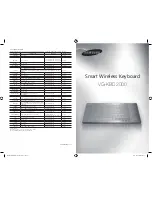
KDFX Reference
KDFX Algorithm Specifications
10-101
Page 2
Wet/Dry
The amount of distorted (wet) signal relative to unaffected (dry) signal.
Out Gain
The overall gain or amplitude at the output of the effect. For distortion, it is often
necessary to turn the output gain down as the distortion drive is turned up.
Dist Drive
Applies a boost to the input signal to overdrive the distortion algorithm. When
overdriven, the distortion algorithm will soft-clip the signal. Since distortion drive will
make your signal very loud, you may have to reduce the Out Gain as the drive is
increased.
Warmth
A lowpass
fi
lter in the distortion control path. This
fi
lter may be used to reduce some of
the harshness of some distortion settings without reducing the bandwidth of the signal.
Cab Bypass
The guitar ampli
fi
er cabinet simulation may be bypassed. When set to “In”, the cabinet
simulation is active; when set to “Out”, there is no cabinet
fi
ltering. [MonoD Cab]
Cab Preset
Eight preset cabinets have been created based on measurements of real guitar ampli
fi
er
cabinets. The presets are Plain, Lead 12, 2x12, Open 12, Open 10, 4x12, Hot 2x12, and Hot
12. [MonoD Cab]
Highpass
Allows you to reduce the bass content of the distortion content. If you need more
fi
ltering
to better simulate a speaker cabinet, you will have to choose a larger distortion algorithm.
[Mono Distortion]
Cabinet HP
A highpass
fi
lter which controls the low frequency limit of a simulated loudspeaker
cabinet. [MonoD EQ and StereoEQ]
Cabinet LP
A lowpass
fi
lter which controls the high frequency limit of a simulated loudspeaker
cabinet. [MonoD EQ and StereoEQ]
Bass Gain
The amount of boost or cut that the bass shelving
fi
lter should apply to the low frequency
signals in dB. Every increase of 6 dB approximately doubles the amplitude of the signal.
Positive values boost the bass signal below the speci
fi
ed frequency. Negative values cut
the bass signal below the speci
fi
ed frequency. [MonoD EQ and StereoEQ]
Bass Freq
The center frequency of the bass shelving
fi
lter in intervals of one semitone. [MonoDistort
+ EQ and StereoEQ]
Treb Gain
The amount of boost or cut that the treble shelving
fi
lter should apply to the high
frequency signals in dB. Every increase of 6 dB approximately doubles the amplitude of
the signal. Positive values boost the treble signal above the speci
fi
ed frequency. Negative
values cut the treble signal above the speci
fi
ed frequency. [MonoD EQ and
StereoEQ]
Treb Freq
The center frequency of the treble shelving
fi
lter in intervals of one semitone.
[MonoD EQ and StereoEQ]
Bass Gain
-79.0 to 24.0 dB
Treb Gain
-79.0 to 24.0 dB
Bass Freq
16 to 25088 Hz
Treb Freq
16 to 25088 Hz
Mid Gain
-79.0 to 24.0 dB
Mid Freq
16 to 25088 Hz
Mid Width
0.010 to 5.000 oct
Содержание K2661
Страница 18: ...2 4 LFOs LFO Shapes...
Страница 34: ...3 16 DSP Algorithms...
Страница 54: ...5 4 MIDI Note Numbers Note Numbers for Percussion Keymaps...
Страница 72: ...7 10 System Exclusive Protocol K2661 System Exclusive Implementation...
Страница 82: ...9 4 Upgrading Sample Memory Choosing and Installing a SIMM for K2661 Sample Memory...
Страница 334: ...10 252 KDFX Reference KDFX Algorithm Specifications...
Страница 340: ...11 6 Glossary...
Страница 382: ...12 42 Triple Modular Processing Alphanumeric Buttonpad Entries for DSP Functions...
Страница 392: ...B 6 SysEx Control of KDFX MSB and LSB...
Страница 442: ...D 20 Contemporary ROM Block Objects Controller Assignments Contemporary ROM Block...
Страница 490: ...H 12 General MIDI Standard Mode Controller Assignments...
Страница 492: ...I 2 Live Mode Objects Live Mode Programs...
Страница 498: ...K2661 Musician s Reference Index...
Страница 500: ......















































